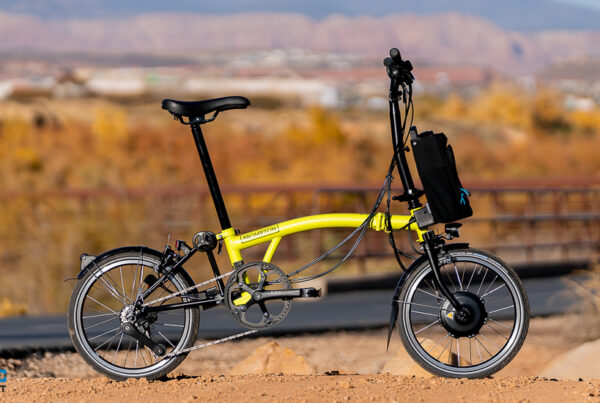The CGO800S features torque sensing power delivery and a single gear; this means all there is to do is press the on button, select one of five power levels using the arrow buttons by your left thumb and pedal off. Dead simple.
Power delivery is silkily smooth, no matter what power level you select. There’s clearly some sophisticated electronics at work to sense pedal pressure here and translate it into just the right amount of power so that it marries with your pedal stroke very nicely.
There doesn’t feel to be a huge difference as you toggle up the power levels from one to five, though go straight from to five and you realise the top level does deliver appreciably more power than the bottom one.
On the flat, into headwinds and up moderate hills there feels to be plenty of power to keep you rolling along near the EU spec assist limit of 16mph; you can almost believe you are doing all the work yourself so quiet is the motor and smooth the power delivery (unless you turn the power off when you realise the motor definitely is assisting you and that this only really a bike for riding without power on the flat, as is the case with most if not all e-bikes).
There is no notable sudden ‘cut out’ of power at around 16mph unless you insist on riding on the flat in the top assist level when you do notice some deceleration at the cut off limit. But get the level right for the conditions and you can bowl along at the assist limit without really noticing that there is a cut off. That’s certainly not a feature of all e-bikes as the cut-off can be annoyingly abrupt on some.
Steep hills are the only real challenge for the motor system; the Mivice M070 rear geared hub motor is little bigger than an eight speed hub gear and clearly at this size there are limits to the power it can deliver on such a city designed e-bike with upright geometry, plenty of ‘extras’ like metal mudguards to add weight and those plush 28” x 2” tyres.
As the gradient steepens the motor starts to slow and eventually runs out of steam at 10% and by this time the test rider was standing on the pedals reasonably hard – in fact a better technique proved to be to keep the pedal pressure light and make steady progress rather than trying to force it.
So perhaps if you live in a very hilly area the CGO800S is not for you. In any event all single speeds will find their limit on steep hills where powerful mid-drives are much the best choice. And as with all single speeds you will find yourself putting more pressure on the pedals in certain situations and maybe standing out of the saddle to leverage your body weight – just to counteract the lack of gears (multi-geared bikes would, of course, have the luxury of dropping down the gears in these situations).
But over our moderately hilly city bike testing ground the CGO800S was a superbly smooth performer, the near silent, smooth motor power making the many hours of test riding a pleasure.
Range Test & Battery Charging
The CGO800S managed 28.4 miles from a full charge using the top power level of five out of five (Boost) on all the time. This was using our city bike / single speed test course which features only moderate hills and is all on tarmac, rather than our trekking test course which features much steeper hills and some off-road tracks. The city bike test course featured 2398 feet of climbing.
Over the same course but switching between power modes the range was 43.2 miles, with much of the time spent in the lower power levels. This featured 3217 feet of climbing.
The climbing power from the motor only declined when the battery capacity meter on the LCD display got to about 4; at 10% it was still giving good performance on the steeper hill climbs on out test course. Below 4% there was still a small amount of power – enough for you to limp home if you get very low on capacity with only a couple of miles to your destination.
The battery capacity meter itself worked fairly well and should be reasonably helpful in letting a rider gauge just how much capacity they really have left – although it does have its own quirks.
It then declines quite quickly to 80% but evens out for much of the rest of the ride until you get to around 10%. This all suggests the meter is measuring the battery voltage as that quick at the start and finish is characteristic of a typical lithium-ion battery discharge cycle.
The meter itself, though, behaves well, so for the middle 70% or so of battery consumption it ticks away steadily and it’s a helpful aid calculating how much battery you really do have left and how far it might take you. There is no range remaining figure on the display, but once you know how far a full charge will take you, the % battery gauge and a bit of simple maths will certainly give a rough idea of the mileage left in the tank.
NB: The range test was conducted in warm but breezy weather. Much colder temperatures can affect range negatively.
Source link








